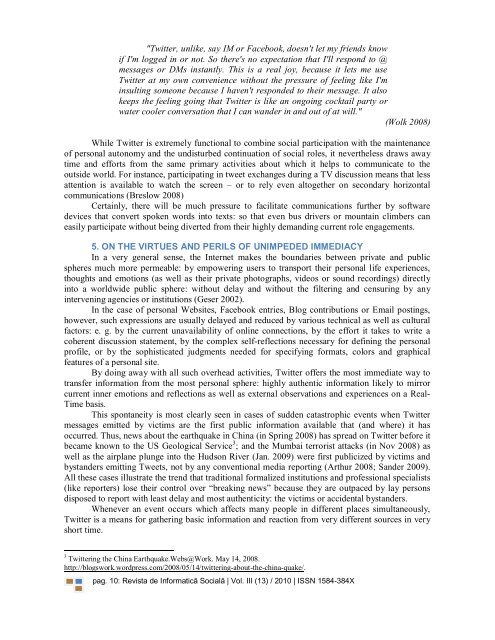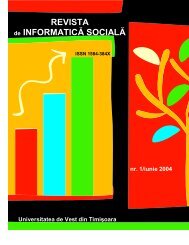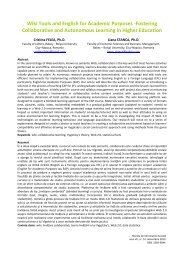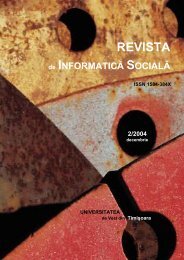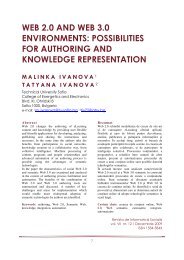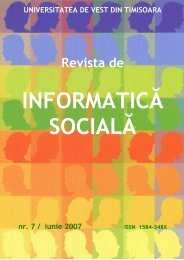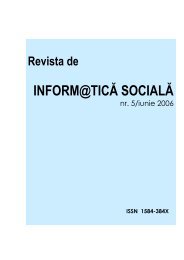No 13 - Journal of Social Informatics / Revista de Informatica Sociala
No 13 - Journal of Social Informatics / Revista de Informatica Sociala
No 13 - Journal of Social Informatics / Revista de Informatica Sociala
Create successful ePaper yourself
Turn your PDF publications into a flip-book with our unique Google optimized e-Paper software.
"Twitter, unlike, say IM or Facebook, doesn't let my friends know<br />
if I'm logged in or not. So there's no expectation that I'll respond to @<br />
messages or DMs instantly. This is a real joy, because it lets me use<br />
Twitter at my own convenience without the pressure <strong>of</strong> feeling like I'm<br />
insulting someone because I haven't respon<strong>de</strong>d to their message. It also<br />
keeps the feeling going that Twitter is like an ongoing cocktail party or<br />
water cooler conversation that I can wan<strong>de</strong>r in and out <strong>of</strong> at will."<br />
(Wolk 2008)<br />
While Twitter is extremely functional to combine social participation with the maintenance<br />
<strong>of</strong> personal autonomy and the undisturbed continuation <strong>of</strong> social roles, it nevertheless draws away<br />
time and efforts from the same primary activities about which it helps to communicate to the<br />
outsi<strong>de</strong> world. For instance, participating in tweet exchanges during a TV discussion means that less<br />
attention is available to watch the screen – or to rely even altogether on secondary horizontal<br />
communications (Breslow 2008)<br />
Certainly, there will be much pressure to facilitate communications further by s<strong>of</strong>tware<br />
<strong>de</strong>vices that convert spoken words into texts: so that even bus drivers or mountain climbers can<br />
easily participate without being diverted from their highly <strong>de</strong>manding current role engagements.<br />
5. ON THE VIRTUES AND PERILS OF UNIMPEDED IMMEDIACY<br />
In a very general sense, the Internet makes the boundaries between private and public<br />
spheres much more permeable: by empowering users to transport their personal life experiences,<br />
thoughts and emotions (as well as their private photographs, vi<strong>de</strong>os or sound recordings) directly<br />
into a worldwi<strong>de</strong> public sphere: without <strong>de</strong>lay and without the filtering and censuring by any<br />
intervening agencies or institutions (Geser 2002).<br />
In the case <strong>of</strong> personal Websites, Facebook entries, Blog contributions or Email postings,<br />
however, such expressions are usually <strong>de</strong>layed and reduced by various technical as well as cultural<br />
factors: e. g. by the current unavailability <strong>of</strong> online connections, by the effort it takes to write a<br />
coherent discussion statement, by the complex self-reflections necessary for <strong>de</strong>fining the personal<br />
pr<strong>of</strong>ile, or by the sophisticated judgments nee<strong>de</strong>d for specifying formats, colors and graphical<br />
features <strong>of</strong> a personal site.<br />
By doing away with all such overhead activities, Twitter <strong>of</strong>fers the most immediate way to<br />
transfer information from the most personal sphere: highly authentic information likely to mirror<br />
current inner emotions and reflections as well as external observations and experiences on a Real-<br />
Time basis.<br />
This spontaneity is most clearly seen in cases <strong>of</strong> sud<strong>de</strong>n catastrophic events when Twitter<br />
messages emitted by victims are the first public information available that (and where) it has<br />
occurred. Thus, news about the earthquake in China (in Spring 2008) has spread on Twitter before it<br />
became known to the US Geological Service 3 ; and the Mumbai terrorist attacks (in <strong>No</strong>v 2008) as<br />
well as the airplane plunge into the Hudson River (Jan. 2009) were first publicized by victims and<br />
bystan<strong>de</strong>rs emitting Tweets, not by any conventional media reporting (Arthur 2008; San<strong>de</strong>r 2009).<br />
All these cases illustrate the trend that traditional formalized institutions and pr<strong>of</strong>essional specialists<br />
(like reporters) lose their control over “breaking news” because they are outpaced by lay persons<br />
disposed to report with least <strong>de</strong>lay and most authenticity: the victims or acci<strong>de</strong>ntal bystan<strong>de</strong>rs.<br />
Whenever an event occurs which affects many people in different places simultaneously,<br />
Twitter is a means for gathering basic information and reaction from very different sources in very<br />
short time.<br />
3 Twittering the China Earthquake.Webs@Work. May 14, 2008.<br />
http://blogswork.wordpress.com/2008/05/14/twittering-about-the-china-quake/.<br />
pag. 10: <strong>Revista</strong> <strong>de</strong> Informatică <strong>Social</strong>ă | Vol. III (<strong>13</strong>) / 2010 | ISSN 1584-384X


